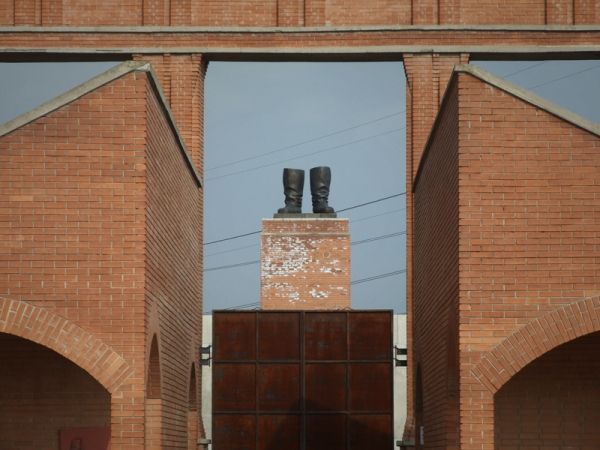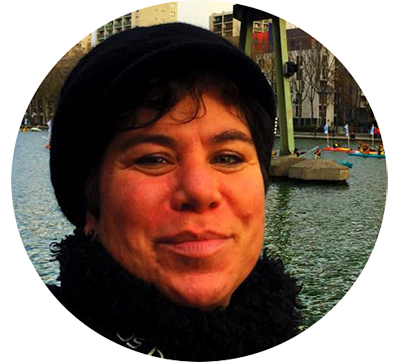Shared Silence


Shared Silence
What should be done with the symbols of white supremacy?
In 1987, when I was sixteen years old, my sister and I travelled to Hungary for the first time. My father was afraid to join us. In 1948, he and his family had fled Budapest—at just ten years old, he escaped while drugged in the trunk of a car. My family left behind the Nazis and Brown Shirts, as well as the totalitarian rulers who took hold of the nation at the end of World War II. He hadn’t been back since; but this did not stop him from allowing his American daughters to take the trip.
We visited our great aunt, who was then eighty-six years old. I had been raised on the story about her, told and retold by my father, of how, one day at the end of the war in 1945, she knocked on his family’s door: “Ez én vagyok, a Nelli, visszatértem Bergen-Belsen-bol,” she said—“I am Nelli. I have returned from Bergen-Belsen.”
That is all that his aunt ever said to him about her nine months held captive as a prisoner in the Nazi concentration camp where Anne Frank was killed.
Aunt Nelli greeted my sister and I warmly at her door. Through our uncle’s translation, we eventually came to understand the full extent of her exuberance at our visit. Nelli believed us to be compatriots, friends preparing to head out together for a swim in the Danube. In Nelli’s mind it was perhaps 1919, a year wedged between the two World Wars. She believed she was, like us, a teenager. The horrors about to be visited upon her never occurred, never became reality. She was young, fun, and free.
The ability of Nelli’s mind to cope with trauma in this way, to forget the very worst experiences that humanity had to offer, gave me a sense of hope that has stayed close to me since that time. But so too has the image of the still-black numbers tattooed on her paper-thin skin.
While in Budapest, my sister and I also visited Felvonulási Tér, Parade Square, the central plaza where state celebrations were held and where a twenty-six-foot-tall statue of Stalin once stood atop a thirty-three-foot perch before pro-democracy demonstrators tore it down in 1956, leaving nothing but his boots behind. The boots too were eventually removed, but their ultimate fate and whereabouts remain a mystery—though pieces of the statue do show up from time to time, such as when the National Museum of Hungary purchased Stalin’s left ear for about $2,000 in 2010. Today, what I remember most poignantly of our visit to the square, is standing beneath a bulking statue of Lenin, craning my neck to view his square staid body raised up on a pedestal towering above me.
In 1991, the last Soviet soldiers left Hungary. A few years later, my sister and I returned. This time, our father joined us. We visited Memento Park, an open-air collection of Soviet-era statues surrounded by barren fields on the outskirts of Budapest. We arrived by train, and as we approached, I noticed the very same statute of Lenin I had seen in 1987, now removed from its place of honor in Parade Square, sitting in a dirt lot outside of the park.
Like other nations across Eastern Europe, after the 1991 collapse of the Soviet Union, Hungary grappled with what to do with the multitude of statues littered throughout the country commemorating the brutal totalitarian and authoritarian regimes that had ruled them for decades. As citizens began pulling down statues of Soviet and Communist rulers, commanders, and battle scenes, local governments debated what to do.
The Budapest General Assembly ultimately decided that all of the statues must be removed, but not entirely erased. The Budapest Art Gallery was given the task of determining what to do with the markers. A competition among architects was held, with thirty-one-year-old Ákos Eleod submitting the winning design for Memento Park. “It is a pleasure to participate in the absence of book burning,” Eleod wrote in the short explanation of his design in 1993.
Memento Park was a meticulously planned, overwhelmingly powerful artistic and architectural experience. A small representative selection of statues, street signs, plaques and other various detritus of the totalitarian past are now here where their meaning can be studied. It is a firm condemnation of oppression, one that recognizes history without revering it. The park’s obligation is to recall a regime, to show the past to future generations, “so that it will never happen again,” said Eleod. It is “a symbol of people’s longing for freedom.”
Other nations adopted the idea, including Poland’s “Socialist Art Gallery,” established in 1994 at the Muzeum Zamoyskich in Kozlówka, and “Monuments Park” at the PRL Museum in Ruda Slaska, created in 2010. During the opening of the “Park of Sculptures” at the Socialist Art Museum in Sofia, Bulgaria in 2011, the Minister of Culture said, “It was high time to put that era where it belongs—in a museum.” Yet none of these, nor the small handful of other similar collections, have matched the intricacy or intentionality of Memento Park’s design.
Memento Park consists of two outdoor areas. The main section is commonly known as Statue Park, but is more precisely named “Egy mondat a zsarnokságról”—or “A Sentence about Tyranny” Park. It is the title of a renowned and crushing 1950 poem by Gyula Illyés which is inscribed on a plaque in the Park. It reads, in part:
Where tyranny exists
that tyranny exists
not only in the barrel of the gun
not only in the cells of a prison…
tyranny supplies
the standing ovation,
the loud hurrahs and chanting of the crowd…
in the uproarious lie
grandiose statues, of colours,
in galleries…
as it waits
outside the gates
tyranny permeates
all manners and all states,…
for he stands over you at your grave,
and tells you who you were,
your every molecule
his to dispose and rule.
“The park was conceived in the same circle of thought – the same silence resounds around the statues as is in the poem,” Eleod wrote. “Pain, grief, impotence, shame, shock, rage and defiance.”
The statue of Lenin sits in a recess at the base of an imposing red brick wall adorned with four tall columns crowned by a towering tympanum. Though more than 130 feet long, it is exposed to be a mere section of wall, neither holding up a building nor extending out in any direction. Walk behind it, and the wall is revealed to be an empty façade: grandiosity demarking nothing. Instead, one finds an open field, in which forty-two statues and other memorials are strategically placed, connected via four carefully groomed paths. Once I began walking, I quickly realized that three of the paths form an infinite loop, perpetually circling a Red Star. These paths all intersect at a central walkway which runs from the entrance wall and dead ends into a low flat section of red brick wall standing isolated and inauspicious in the distance, as if abandoned there and then forgotten. The design is “in reference to the idea that the arrogant and boastful ideology has proved to be a dead end in history,” wrote Mano Gabor Toth, a graduate student at the Central European University in Budapest with whom Eleod discussed the park in 2011.
Eleod envisioned Statue Park as a place for quiet contemplation. “A foreign tourist, for whom dictatorship is merely something they have read about, has completely different thoughts when in the park than the person with a tragic past, who lived here, survived and under the aegis of these statues takes the drama of his own ruined life into the park with him,” he once wrote. “But the silence is shared.” Nearby Witness Square, however, is meant for noise, crowds, classes, and loud discussion. In it is a replica of the remnants of Stalin’s statue —his boots—now sits. It is named for the well-known Hungarian film The Witness, which ridiculed the Stalinist era (and was banned during it). The boots are a celebration of those Hungarians who took down the statue in their attempt at revolution in 1956.
Eleod’s hoped that Memento Park would be a revolutionary statement. “This Park is about dictatorship, but as soon as this can be talked about, described and built, the park is already about democracy,” he said. Publicly challenging, condemning, questioning, and discussing brutality is how people and a nation can begin to move away from it.
I thought about Memento Park this summer as Nazis and white supremacists descended upon Charlottesville, Virginia. Some 250 mostly young white men marched at night with torches to the statue of Confederate general Robert E. Lee while chanting “white lives matter” and “Jews will not replace us,” and then, the next day, thousands more congregated around the statue ready to riot; some carried shields and long wooden clubs, a few brandished hand guns and semi-automatic weapons. The day turned deadly after a white supremacist drove his car into a peaceful march held by counter protestors, killing thirty-two year old Heather Heyer, and injuring dozens more.
And I thought about Memento Park again the next day, when Takiyah Thompson and other activists used a rope to pull down and ultimately destroy the Confederate Soldiers Monument in Durham, North Carolina. And again, not even two days later, when the city of Baltimore removed four of its Confederate monuments, and when the Hollywood Forever Cemetery in Los Angeles removed a monument commemorating Confederate veterans, moving it to an undisclosed location. I thought about the park this winter, when New York City announced it would remove from Central Park a of statue of J. Marion Sims, a nineteenth-century gynecologist who experimented on enslaved women.
I wondered: can the park offer insight into how we in the United States address our past—the idolatry of the Confederacy, and with it the ideology of white supremacy? As the statues comes down—as they should—couldn’t some end up in a similarly well-crafted location?
The Southern Poverty Law Center has identified more than seven hundred monuments and statues commemorating the Confederacy on public property throughout the country, nearly three hundred of which are in Georgia, Virginia, and North Carolina. Many of these sites have recently become the location of violent white nationalist protests. In its report, “Whose Heritage? Public Symbols of the Confederacy,” the Center writes that Southerners began honoring the Confederacy with statues and other symbols almost immediately after the Civil War, with a steady stream of dedications in the following one hundred and fifty years. The largest number of dedications occurred from 1900 to the 1920s, in the wake the 1896 US Supreme Court Plessy v. Ferguson decision upholding state racial segregation laws enacted to disenfranchise the newly freed slaves. “It was a period that saw a dramatic resurgence of the Ku Klux Klan, which had been born in the immediate aftermath of the Civil War,” wrote the Center. A second wave of dedications took place in the 1950s and 1960s, in retaliation to the civil-rights movement.
While groups have objected to these statues for decades, they found little success. “But everything changed on June 17, 2015,” the Center wrote, when a young white supremacist murdered nine African-American parishioners at Charleston’s Mother Emanuel church, a place “renowned for its place in civil-rights history.” Photos of the gunman with the Confederate flag disseminated quickly online. Almost immediately, people began to organize, demanding that the flag and other Confederate symbols be removed from public spaces across the South.
One group took matters into their own hands. As others provided support, Bree Newsome climbed a flag pole in front of the South Carolina state capital and removed the Confederate battle flag herself. “This is not simply about a flag, but rather it is about abolishing the spirit of hatred and oppression in all its forms…I did it for all the fierce black women on the front lines of the movement and for all the little black girls who are watching us. I did it because I am free,” said Newsome at the time. As in Hungary in 1956, the action helped to transform the public debate. The Center subsequently recorded more than one hundred attempts at the state and local levels to remove symbols of the Confederacy, or add features to provide more historical context.
The debate has echoed discussions in Hungary in the early Nineties, when there was far from universal agreement that the statues of its totalitarian past should be removed—or what to do with them if they were. A public poll taken in 1992 found that as many as nine percent supported destruction of at least some of the statues, and another ten percent supported removing them to storage. The rest of the public was fairly evenly split between those who advocated placing them in a purposefully built park and leaving them where they stood.
For an individual such as my great aunt Nelli to heal, erasure may be the sanest of choices. But of course, with the erasure of the Holocaust from her mind, everything else that had taken place in her life over the previous seventy years had also vanished. For a nation to transcend the monumental injustice of white supremacy, the obliteration of memory is not only impossible, it is incapable of bringing about the necessary transformations in a society. White supremacy still pervades every aspect of American life—our schools, our cities, our politics, our workforce. Thompson and Newsome forced us to see that to eradicate it, we must first acknowledge it. As Eleod wrote, “This park is not about the statues or the sculptors, but a critique of the ideology that used these statues as symbols of authority.”

